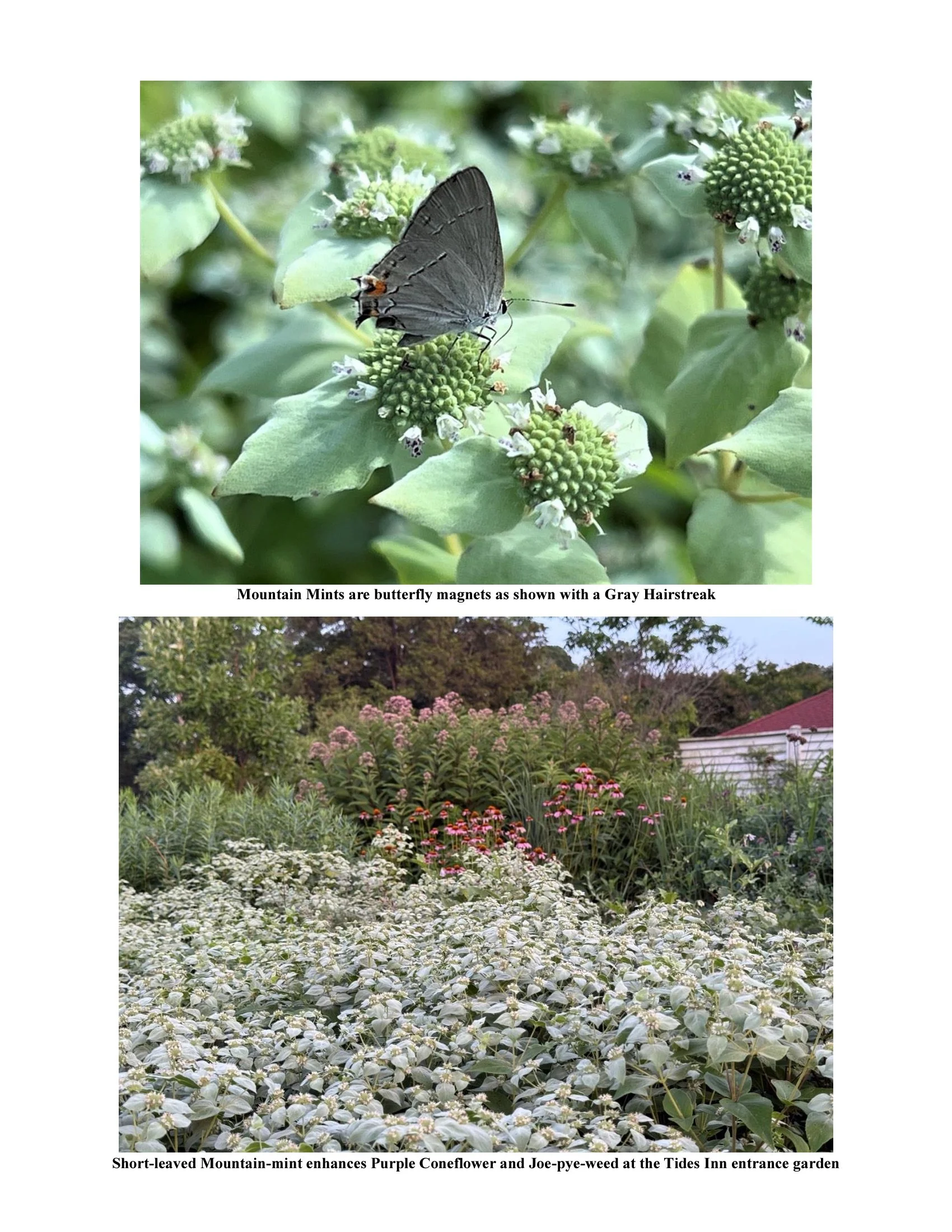Plant of the Month July 2025: Short-toothed Mountain-mint
One of my all-time favorite pollinator plants, Short-toothed Mountain-mint, has just recently been added to the flora of the Northern Neck and I am thrilled to include it as the July Plant of the Month. Several large populations of this incredible pollinator powerhouse were recently discovered near Fone’s Cliff in Westmoreland County and are now listed in the Virginia Digital Atlas for this county. This is just one of about 50 examples of new botanical discoveries and county records being recognized in Northern Neck and Middle Peninsula by observant native plant enthusiasts, citizen scientists, and botanists. Short-toothed Mountain-mint is found in bogs, fens, damp to wet meadows and clearings throughout central and eastern Virginia and a few counties in the mountains but is infrequent throughout.
Short-toothed Mountain-mint, is a member of the mint family, the Lamiaceae, and is more closely related to the mint family’s Beebalms and Wild Bergamot in the genus Monarda, than to true mints. But all are recognized for their aromatic, minty-smelling foliage that deters herbivores like deer, as well as for their square stems and opposite leaves and small tubular flowers attractive to pollinators; however Short-leaved Mountain-mint stands out even from this crowd of pollinator pleasers. Penn State Extension undertook a three-year study of 86 native perennials known for their attractiveness to pollinators and found that Short-toothed Mountain-mint had more pollinator visits and attracted the most diverse group of pollinators including bees, butterflies, wasps, syrphid and tachinid flies over a longer period than any others. Oh, what a long-blooming pollinator magnet!
Pycnanthemum, the Latin name for all 15 of the Virginia Mountain-mints, means “dense” (pyknos) and “flower” (anthos) referring to the densely packed flowers. Short-leaved Mountain-mint is so named for its opposite, oval leaves that have short or blunt teeth and blunter tips than other species. The upper pairs of leaves (bracts) are distinctively velvety and whitened, highlighting the small two-lipped, tubular flowers and adding a dramatic touch. It is also called Clustered Mountain-mint for the dense heads of small tubular flowers held in tight clusters. Each small flower is white to lavender-tinged with small purple spots and as is often true – beauty is in the details so look closely! The upper lip has two lobes while the lower lip has three and they create a gorgeous sensation in the garden held above the velvety bracts blooming from mid-June through August. Short-toothed Mountain-mint forms erect compact bushy clumps reaching 2 - 3 feet in height and nearly as wide.
This species is easy to grow in in full sun or part shade, in average to moist soils and is quite drought tolerant once established. Like other Mints, Short-toothed Mountain-mint spreads by rhizomes and can form large clumps in moist favorable sites but is not considered “invasive” or nearly as aggressive as true mints, especially when combined with other vigorous growers like Wild Bergamot or Switchgrass. It is easy to limit its spread by pulling unwanted plants or root pruning with a shovel in early spring. The silvery bracts and long-lasting flowers blend well with most other plants, adding lovely texture and color to the landscape. As an added bonus, Short-toothed Mountain-mint resists nearly any type of herbivore – deer, rabbits, even groundhogs, and has no serious disease or insect pests. Planted beside other plants that are susceptible to herbivore damage, Mountain-mints can help protect them.
Not only does Mountain-mint attract more numerous and more diverse pollinators, but it is also the host for the larvae of the Wavy-lined Emerald moth, and the small seeds provide food or songbirds in September and October. The fragrant leaves have long been used to make a tasty minty tea and for flavoring and Native Americans used a decoction of mountain-mint to treat fevers.
No matter how you use this plant, it creates a wonderful, long-lasting show in the garden and brings it alive with pollinators. The flowers are long-lasting both in the garden and in cut flower arrangements while later the seedheads add winter interest and food for wildlife. No wonder it was chosen by the Perennial Plant Association as the 2025 Perennial of the Year! Try Short-toothed Mountain-mint in a pollinator, cottage, children’s, sensory or a cutting garden. Here in the Coastal Plain, Short-toothed Mountain-mint is especially well suited to meadows or upper shorelines where it will spread into colonies creating a gorgeous garden. No matter where you try it, Short-toothed Mountain-mint is sure to be a hit. Note that its close cousin, the equally charming Narrow-leaf Mountain-mint, which is more compact with very fine-leaves, is also native to most of Virginia including Northern Neck and was featured as the NNVNPS July 2021 Plant of the Month – www.nnvnps.org).



